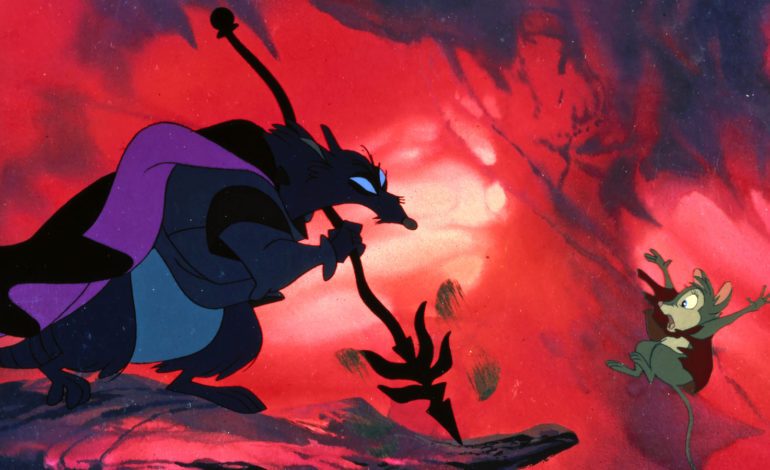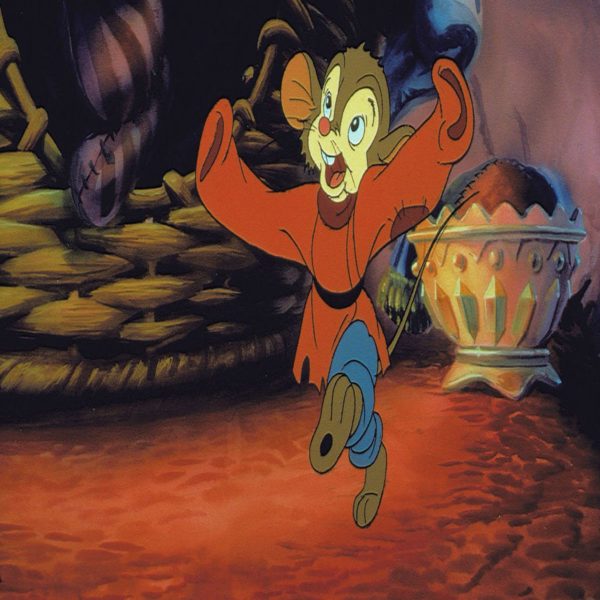

In the world of animation, there is one name that looms above all: Disney. Since the 1930s the Walt Disney Company has been regarded as the gold standard of animation, occasionally running into competition from the likes of Warner Bros. and DreamWorks but maintaining its cultural relevancy nonetheless. Disney would even acquire Pixar and its impressive catalogue of animated features. Despite the company’s too big to fail image today, there was a time not all that long ago when the animation department at Disney almost went bankrupt. The 1980s are known as the “Disney Dark Age” and marked by underperforming films and a lack of cultural importance. When the future of Disney looked uncertain, another name in animation began to rise to prominence, Don Bluth. If the 80s were Disney’s dark ages, then for Bluth it was a renaissance. Through films like The Secret of NIMH, An American Tail, and The Land Before Time, Bluth was able to bring renown back to the art form and show just how powerful animation could be in storytelling.
Bluth was a former employee of Disney, even working on films as far back as Sleeping Beauty in 1955. After leaving Disney for a little bit he would come back in the early 70s and work on the likes of Robin Hood and The Rescuers. Bluth’s relationship with the Walt Disney Company would break apart while working on The Fox and the Hound. His relationship with the company had already been strained, with him citing the death of Walt Disney to be the shift to a design by committee system that he didn’t care for. Bluth only worked briefly on the film before he and several other animators resigned and formed their own company, Don Bluth Productions. Fox and the Hound ended up receiving mixed reviews, criticized for not breaking any new ground. It would kick off the previously mentioned Dark Age.
When Bluth and the other animators left they got to work on their first full length animated feature, The Secret of NIMH. The film, based on the children’s book Mrs. Frisby and the Rats of NIMH, deals with a widowed mouse named Mrs. Brisby desperate to move her family before her home in a farmer’s field is destroyed. On her journey she meets a colony of rats who have been genetically experimented on. The film becomes race against the clock to save her family while being caught between the feuding rats. The film was met with high praise, lauded for its darker, more mature story and distinct visuals. In an era when Disney was playing it very safe, NIMH offered a unique story with engaging characters that didn’t shy away showing a more serious story to children. Despite the praise, the film did poorly at the box office and the Don Bluth was forced to shut down his animation company.


In the interim between feature films, Bluth would make history with the arcade game Dragon’s Lair. Less of a traditional video game, it was essentially a point and click adventure game. The player would play as a knight see be presented with a set of paths or options to take. Making the wrong choice would result in failure, and all the scenes were portrayed through traditional hand drawn animation as opposed to animated sprites. The game was a massive success in large part due to its novel animation and presentation.
Bluth would soon enter a partnership with Steven Spielberg and his next film, An American Tail, would do much better at the box office. American Tail, much like NIMH, told a darker and more somber story than many contemporaries. The film focuses on a young mouse named Fievel Mousekewitz who immigrates with his family to America. Along the way he is separated from his family and film tells the story of him trying to find his way back to them in an unfamiliar land. The film is generally regarded as one of Bluth’s best and is also notable for its portrayal of the Mousekewitzes as a poor Jewish family looking to escape persecution. Despite the film now delving too much into the subject, it was yet another example of Bluth’s works tackling bigger issues. The film did well critically but some considered the film potentially too dark and somber for children.
Bluth would see financial and critical success again with 1988’s The Lane Before Time. It tells the story of a young Apatosaurus named Littlefoot who is orphaned at the start of the film and must find the way to his grandparents in the sanctuary known as the Great Valley. He and the friends he makes along the way go through incredible danger and learn to trust and become close with one another. Land Before Time outgrossed Bluth’s previous efforts and once again pushed for a more challenging experience for younger viewers. The death of Littlefoot’s mother is shown on screen in one of the most heartbreaking sequences in animation and this film especially among Bluth’s was regarded for its stunning animation and art.


Bluth would continue to make animated features for years and years but none would quite reach the same level of regard as the three mentioned above. He broke off his partnership with Spielberg following The Land Before Time and his films throughout the 90s underperformed financially and were negatively received. He managed to get a hit with Anastasia but it remains incredibly distinct and removed from his efforts in the 1980s. It’s hard to say if something suddenly changed in the 90s for him. NIMH before his partnership with Spielberg and All Dogs Go To Heaven after the fact managing to be successful be it critically or financially so one can’t just point fingers at him splitting with Spielberg as the cause for the drop in quality. Whatever the reason, Disney would strike gold in 1989 with The Little Mermaid, ushering in the Disney Renaissance and putting Disney back on top in the world of animation with hit after hit.
Truthfully, it doesn’t matter if he never quite captured that same level of success again. The trio of films Bluth put out from 1982 to 1988 remain some of the best animated works out there. Many of Bluth’s critics at the time took issue with the darker stories, finding them unsuitable for children to watch. However, what Don Bluth does with his films is actually treat the children in the audience with a degree of respect. There’s nothing wrong with a piece of light entertainment. Making people smile or have a laugh is a wonderful thing to do as an artist. As always though, there is room for both. The light and the dark. Children are very impressionable and are easily shaped by the media they consume. It’s a fine line between what is suitable for children and what isn’t, but completely sheltering them from the world does them a tremendous disservice. Bluth’s films usually have a dark tone, but that darkness and danger throughout makes the happy endings to his films all the more poignant. There are few things as cathartic as the tearful reunion of the Mousekewitz family or the grand reveal of the Great Valley.
The Secret of NIMH tells the story of a widowed mother who will do anything to save her family. An American Tail tells the story of Jewish immigrants and importance of family. The Land Before Time tells the story of an orphan and his found family learning to grow up and put aside prejudices. These concepts don’t often get portrayed in children’s media. And why shouldn’t children’s media be well made and sincere? There’s sometimes this notion of apathy towards works aimed at children. “It’s just for kids, who cares they’ll watch anything”. What Don Bluth did with his films throughout the 1980s was challenge that notion. Children deserve to have well-made works of art too. Bluth told stories that could only ever be brought to life through the medium of animation. There seems to be this notion that animation can only be for kids unless it’s full of coarse language and explicit jokes. See most “adult animation” on TV nowadays. Bluth’s films can be enjoyed by all ages and are brought to life by gorgeous hand drawn animation. They should serve as a template for all animators as an example of just how powerful animation can be when telling a story.
